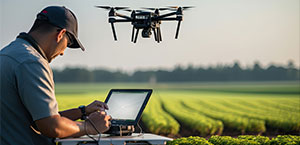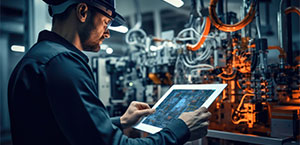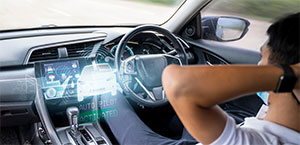This article explores the recent developments and capabilities of AI, specifically focusing on machine vision. It highlights how AI is transforming industries such as healthcare, agriculture, manufacturing, and automotive.
When it comes to transformational technology trends, the impact of artificial intelligence (AI) can’t be overemphasized. This groundbreaking advance is enabling data analysis, pattern recognition, robotic automation and perceptual awareness that replicates human-level analytical efficiency. “Smart” applications are becoming more prevalent, powered by sophisticated learning algorithms and neural processing networks that support complex calculations and rapid decision-making. Projected to become a $2-trillion market by 2030, AI is set to revolutionize output and adaptability across industries.
As intelligent and information-driven AI use cases continue to emerge, their productivity potential is nearly on par with their intensive power demands — which means that the need for reliable connector assemblies, sophisticated sensors and significantly increased data center throughput has never been more imperative. Let’s take a closer look at recent AI developments through the lens of its perceptual capabilities, particularly machine vision.
AI Overview: Waves of Unprecedented Insight
Ever since The Dartmouth Summer Research Project on Artificial Intelligence convened in 1956, AI has been considered revolutionary. With OpenAI’s generative ChatGPT now a household term, AI’s progression has been divided into “waves” by the Defense Advanced Research Projects Agency (DARPA). Rule-based systems were developed in the first wave, while the second wave of data set training, perception and statistical learning is where we presently sit.
This means that AI currently makes it possible for electronic and mechanical systems to:
- Discover and recognize. Machine learning (ML), a critical subset of AI, refers to the technologies and data training algorithms that allow AI-based systems to identify patterns and draw logical conclusions — cumulatively building on experience to accelerate comprehension. Using a combination of AI and ML, automated equipment can now assess its surroundings, recognizing inputs to make rapid contextual decisions.
- Sense and see. With the help of advanced sensors, AI allows computers and robots to detect environmental information that supports intelligent assessment. Machine vision, sometimes called computer vision, is the ability of a mechanized system to perceive and process observations in ways that support plausible action. Powered by a range of sophisticated hardware and software components, machine vision relies on AI for its ability to analyze, interpret and adapt. Think of machine vision as the ability to give modern equipment “eyes” —
a futuristic concept that’s gradually becoming a reality.
Envisioning AI Efficiencies
AI, ML and machine vision capabilities are poised to help perception-based sensors and smart applications transform efficiency across the business and consumer landscape. Some promising industry examples are summarized below.
 Today’s rapidly evolving healthcare sector is proof that AI advances are improving lives. In terms of machine vision, tools exist that can accurately detect suspicious-looking skin lesions. Other devices are being evaluated that help predict the likelihood of coronary artery disease by analyzing visual scans.
Today’s rapidly evolving healthcare sector is proof that AI advances are improving lives. In terms of machine vision, tools exist that can accurately detect suspicious-looking skin lesions. Other devices are being evaluated that help predict the likelihood of coronary artery disease by analyzing visual scans.
Perhaps one of the most promising medical developments involves data-driven surgical robots that help improve visualization and accuracy during procedures, with AI-assisted intra-operative guidance. Challenges of navigating the human body include tight spaces, intricate structures and moisture ingress — so to ensure patient safety and reliable performance, these highly maneuverable robots often employ a combination of sealed connectors, microelectronics, miniaturized sensors, camera equipment and fiber optics.
Collectively, these elements help skilled human physicians deliver minimally invasive care by accessing and viewing precisely defined anatomical areas to make real-time, AI-supported perceptual decisions. This often drastically reduces the size of incisions — thereby increasing safety, reducing pain and scarring, speeding patient recovery time and curtailing expense. Thanks to surgical robots, many procedures that once required extended hospital stays can now be performed at outpatient ambulatory facilities.
 Providing the world’s food supply is a vital undertaking, so the agricultural industry has been experimenting with smart technologies for some time. As a result, AI is already delivering a bumper crop of enhancements that impact key farming activities.
Providing the world’s food supply is a vital undertaking, so the agricultural industry has been experimenting with smart technologies for some time. As a result, AI is already delivering a bumper crop of enhancements that impact key farming activities.
In terms of managing livestock, machine vision and sensors are being combined with AI-integrated devices and drones to monitor animal welfare, keep track of herds, evaluate feeding rates and assess behavioral patterns. One example: Infrared imaging is being evaluated to help “see” concerning health symptoms and living conditions, while AI-trained models learn to recognize abnormal animal movements.
Many of the sensors used in modern animal tracking systems are wearable, transmitting data to the cloud via low-bandwidth communication. For instance, innovative robotic grazing monitors use electronic leg bands that interact with animal-mounted sensors to assess social interaction and feeding patterns. Similarly, biosensor-based smart collars are used in regions like Scotland to monitor cow fertility.
With respect to crop management, smart greenhouses integrate sensors with actuators, HVAC technology, irrigation systems and lighting to help visualize, automate and optimize plant growth. In fact, the term “precision agriculture” has been coined to describe the collective use of AI-supported sensors, global positioning system (GPS) monitors, wireless communications, and unmanned aerial vehicles (UAVS) to oversee farming efficiency. For example, today’s smart tractors leverage sensor networks, AI-driven visual monitors, onboard controllers and other advanced technologies to automate certain driving functions, pre-measure and place seeds, apply fertilizer, evaluate yields and transmit information about equipment fuel levels.
 Industry 4.0, the fourth industrial revolution, empowers manufacturers to capture and analyze information in ways that reduce productivity bottlenecks and improve material handling. The ever-expanding Industrial Internet of Things (IIoT) is spawning interconnected smart factories that are increasingly enhanced by ML applications and the use of machine vision. In fact, Grandview Research suggests that escalating needs for automation and improved quality inspection processes will continue driving machine vision adoption across industrial settings — with the market expected to grow at a CAGR of 7.7% between now and 2030.
Industry 4.0, the fourth industrial revolution, empowers manufacturers to capture and analyze information in ways that reduce productivity bottlenecks and improve material handling. The ever-expanding Industrial Internet of Things (IIoT) is spawning interconnected smart factories that are increasingly enhanced by ML applications and the use of machine vision. In fact, Grandview Research suggests that escalating needs for automation and improved quality inspection processes will continue driving machine vision adoption across industrial settings — with the market expected to grow at a CAGR of 7.7% between now and 2030.
The manufacturing floor introduces an array of potential machine vision use case scenarios. Assessing equipment health is one example. Manufacturers already use AI to analyze data from sensors and machinery on the factory floor, helping to predict the likelihood of equipment failure. As machines perform routine self-checks, machine vision can leverage predefined learning algorithms to “see” operational issues and expedite proactive repairs.
In terms of product manufacturing, automated assembly lines are starting to apply localized, machine-to-machine (M2M) logic governed by sophisticated ML modules that analyze information to self-adjust in real time. Machine vision can help to rapidly assess materials at each stage of assembly, removing defective items as they’re identified. Similar advantages extend to additive manufacturing, often called 3D printing, where machine vision can help to spot early errors and prototyping issues before they cause expensive defects in a complex finished product.
Machine vision is making industrial robots more advanced as well. Whereas early factory robots could only use sensors to gauge factors like vibration and temperature, machine vision can enable perceptual learning that helps robots recognize tiny cracks or other imperfections.
 Today’s vehicles are increasingly electrified — and in the not-too-distant future, many will be fully self-driving as well. This revolution demands the seamless integration of numerous sensors, cameras, antennas, cables and connectors reliably transmitting data for rapid analysis.
Today’s vehicles are increasingly electrified — and in the not-too-distant future, many will be fully self-driving as well. This revolution demands the seamless integration of numerous sensors, cameras, antennas, cables and connectors reliably transmitting data for rapid analysis.
Powered by these complex communication relays, self-driving cars use AI to interact with other vehicles while identifying road signs, traffic signals and pedestrians in real time. As machine vision becomes increasingly prevalent, it holds the key to safe and dependable autonomous vehicle operation.
Within the cab, for instance, machine vision has the potential to determine whether a driver is dozing off — alerting the vehicle to sound an audible alarm. Outside the vehicle, machine vision can augment AI-supported sensors and cameras to interpret infrastructural elements that indicate available charging stations or parking spaces. This same technology can also continue to enhance vehicle-to-vehicle (V2V) communication, helping cars “see” signs of an impending lane change or identify hidden hazards to avoid collisions.
Of course, most automotive assembly lines are already utilizing machine vision to detect new parts, assist with quality inspection, help robots place components and more. Few industries expose electronic systems to a wider range of grueling conditions than transportation — so in terms of AI-driven smart factory enhancements, the transportation sector is leading by example.
Conclusion: Industries Evolving with AI
AI is proving extraordinarily adept at speeding time-to-insight and transforming efficiency. As advanced capabilities like machine vision are employed across a growing variety of use case scenarios, it’s increasingly likely that the DARPA-defined third wave of AI will eventually come to pass: namely, the ability for machines to make inferences and explain their decisions.
To optimize AI-driven productivity, however, power and data management capabilities must continue to expand exponentially. This calls for increased data center speed and capacity, advanced sensors and microelectronics, and ultra-reliable connectors built to withstand harsh environments. With decades of engineering expertise and globally integrated experience across all major industries, Molex and Arrow Electronics are delivering leading-edge connectivity solutions that help today’s technology companies and design engineers drive continued innovation.






